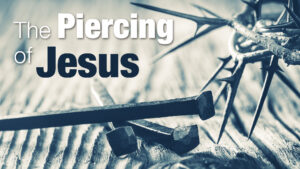The Piercing of Jesus
The Piercing of Jesus
For dogs have surrounded Me; The congregation of the wicked has enclosed Me. They pierced My hands and My feet (Psalms 22:16).
Then they will look on Me whom they have pierced; they will mourn for Him as one mourns for his only son, and grieve for Him as one grieves for a firstborn (Zechariah 12:10).
The first prediction obviously has as its setting the scene of the cross. The timeframe of the second is less certain, but undoubtedly refers back to the same crucifixion event. In any case, the allusion to being “pierced” is confirmed by the first century apostle John. Describing the crucifixion scene, specifically, the incident pertaining to the breaking of the legs of the two thieves, John reports concerning Jesus, who was already dead: “But one of the soldiers pierced His side with a spear, and immediately blood and water came out” (John 19:34). John immediately identifies the incident as a fulfillment of the prophecy of Zechariah (vs. 37). He later alludes to this same piercing in connection with the coming of Jesus (Revelation 1:7).
Jesus experienced two distinct “piercings” on the occasion of the crucifixion. First, His hands and feet were pierced by the nails driven into His hands and feet and into the wooden cross by the Roman soldiers.
Second, we are informed that shortly after He expired, a Roman soldier pierced His side, as if to ascertain for certain that He was deceased. None of the Gospel writers refer explicitly to Psalm 22:16 in connection with the crucifixion. Yet, the connection is all too obvious, not only because His hands and feet were, in fact, pierced by nails, but from the fact that Psalm 22 is riddled with several other Messianic predictions, including the ridicule heaped upon Him, the wagging of His enemies’ heads, and the dividing of His garments, as well as the graphic description of His depleted physical condition that characterized a crucifixion (i.e., the stretching of the skeletal framework, the extreme thirst, and the impact on the heart and chest cavity).1
The question to consider is how could the Psalmist (cir. 1,000 B.C.) and Zechariah (cir. 500 B.C.) anticipate that hundreds of years into the future the Messiah would be executed, and that that execution would include “piercing”? Stoning was the prevailing form of execution that typified Jewish society (Exodus 19:13; Leviticus 20:27; 24:14,23; Numbers 15:36; Deuteronomy 17:5; Joshua 7:25; 1 Kings 12:18; et al.). They certainly did not use crucifixion as a form of execution,2 and the Roman Empire did not exist. Even if the Psalmist and Zechariah were familiar with crucifixion, how could they possibly predict with minute precision the piercing that Jesus endured? With so many forms of execution possible, what are the odds that both prophets would select “piercing”? Such specificity discourages guesswork. The charlatan remains vague and ambiguous rather than risk detection due to particularity. Since the Old Testament canon was complete two and a half centuries before Christ came to Earth, how could the Psalmist and Zechariah make such an exact prediction hundreds of years in advance? The only rational conclusion is that, as they claimed, they were supernaturally guided in their pronouncements.
Endnotes
1 For the medical aspects of the crucifixion of Christ, see William Stroud (1847), Treatise on the Physical Cause of the Death of Christ and Its Relation to the Principles and Practice of Christianity (London: Hamilton & Adams), p. 153. See also B. Thompson and B. Harrub (2002), An Examination of the Medical Evidence for the Physical Death of Christ (Montgomery AL: Apologetics Press); W.D. Edwards, W.J. Gabel, and F.E. Hosmer (1986), “On the Physical Death of Jesus Christ,” Journal of the American Medical Association, 255[11]:1455-1463, March 21.
2 “Among the modes of Capital Punishment known to the Jewish penal law, crucifixion is not found”—Emil G. Hirsch (1903), The Jewish Encyclopedia (New York: Funk & Wagnall), 4:373.

REPRODUCTION & DISCLAIMERS: We are happy to grant permission for this article to be reproduced in part or in its entirety, as long as our stipulations are observed.



0 Comments:
Post a Comment
<< Home